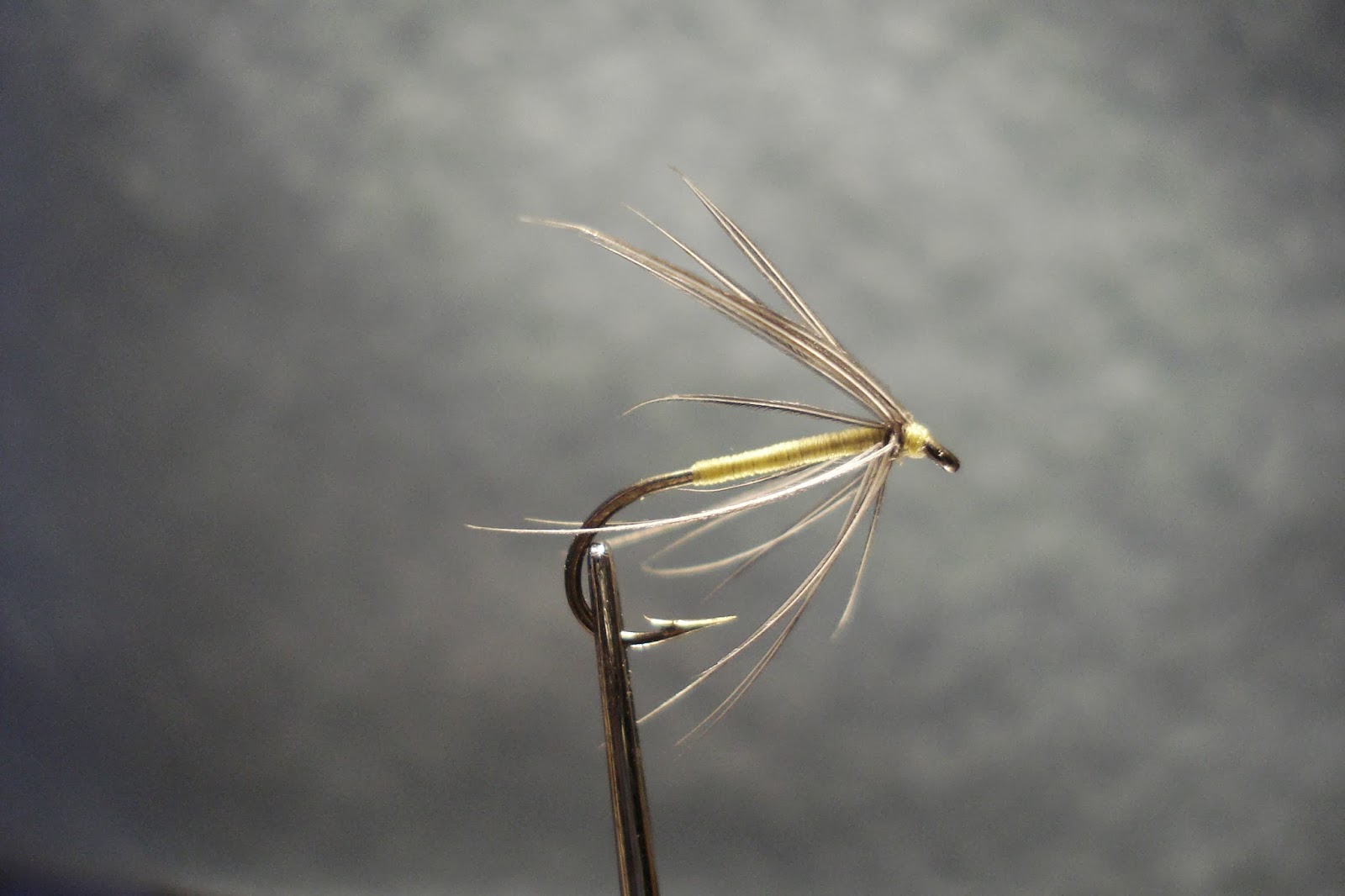 |
| This dressing of Harfield Edmonds and Norman Lee's Waterhen Bloa uses lemon yellow Pearsall's Gossamer silk. |
Hook:
|
14-18
|
|
Thread:
|
Yellow
|
|
Body:
|
Yellow Pearsall’s Gossamer Silk dubbed with
mole’s fur
|
|
Hackle:
|
Dark waterhen coverts
|
|
Multiple twentieth-century fly tiers recommend the Waterhen Bloa in a variety of sizes, including Harfield Edmonds and Norman Lee who list the Waterhen Bloa as No. 2 in their Brook and River Trouting (1916). They list it as a fly matching mayflies from “March to end of April, and again in September), and they dress it thus:
WINGS.-Hackled with a
smoky grey feather from the under coverts of a Waterhen’s wing. (The darker
side of the feather towards the head of the fly.)
BODY.-Yellow silk, No.
4, dubbed with Mole’s fur.
HEAD.-Yellow silk.”
Scottish angler E. M. Tod included the
Water-Hen Bloa at the head of a list of “useful hackled flies (‘spiders’)” at
the end of his Wet-Fly Fishing, Treated Methodically (1903):
“I. WATER-HEN BLOA (SCOTTICE ‘BLAE’).
Body.—The yellow tying
silk, clubbed with water-rat (or mouse) fur, sparingly put on and
ribbed over with the same silk.
Hackle.—From the inside of
wing feather of water-hen.
Season. A generally
useful fly all through the season, and the best fly of its kind, in my
opinion, for the fishing of ‘Waters.’ Very valuable also in river
fishing.”
Their pattern is almost an exact duplication
of the Water-Hen Bloa, No. 8, which T. E. Pritt included in North-Country Flies (1886), except
that Pritt preferred “water Rat” to mole, much like the dressing for the
Waterhen Bloa that Francis M. Walbran included in his monthly column “Monthly
Notes on North-Country Trout Flies” in The
Fishing Gazette, dated 10 October 1885, and which Sylvester Nemes reprints in Two
Centuries of Soft-Hackled Flies (2003). Pritt notes that the Waterhen
Bloa “is identical with the blue dun of Ronalds, and is indispensable during
March and April, and again towards the latter end of the season. It is also a
useful grayling fly all through the winter month . . . The hackled fly is,
perhaps, preferable, as the real fly hatches out mainly on cold, windy days.
If the day be warm the insect takes flight immediately on reaching the
surface of the water; but if, as is commonly the case, the day is cold, it
lingers on the surface, not completely hatched into perfect form, and is thus
easily pounded upon by expectant trout." Sylvester Nemes recommends Pritt's Waterhen Bloa dressed on a size 20 hook in his 2006 additions to his original Soft-Hackled Fly (1975).
Alfred Ronalds, whose dressing for the Little
Pale Blue Dun (no. 43) seems to be the pattern Pritt has in mind, dresses his
fly for September in The Fly- Fisher’s Entomology (1836). The dressing for his Little Blue
Dun calls for
“BODY. Very pale blue fur mixed with a very little yellow mohair.
WINGS. Feather from the sea swallow.
LEGS. The palest blue hackle to be had.
To make it buzz, a
sea swallow’s feather only may be wound upon the same body.”
If Ronald’s dressing is the same that Pritt
cites, then it is a dressing that is included almost feather-for-feather and
fur-for-dubbing in the Bowlkers’ Art
of Angling (1758, 1774), a much closer match than the Water-hen Bloa.
Each list it as the “The Little Pale Blue,” and many British anglers,
following the lead of the Bowlkers, include a dressing for the Little Pale
Blue in their books.
Perhaps the
Bowlkers are dressing flies in a tradition that began before them. Charles
Cotton dresses a “a little dun” with “the dubbing of a Bears dun whirl’d upon
yellow silk, the wings of the grey feather of a Mallard.”
|
 |
| This version of John Swarbrick's dressing for the Blo Flie uses primrose Pearsall's Gossamer Silk |
The simplest version of the Waterhen Bloa appears
in an 1807 publication by John Swarbrick that Leslie Magee reprints In Fly Fishing: the North Country Tradition.
It is a simple North Country spider, the Blo Flie, No. 4, about which Swarbrick explains:
"This is a Blo
Flie made from under the wing on a Water Hen some Times Make it of a large
Feather and Some Times of the Small Not Harled at the Head it is a Hackle
Made with yallow Silk and not very large.
Fish these Four Last Mentioned Flies [Winter
Brown, Little Black, Large bloo, Blo Flie] Till about the 15 or 20 0f March
when you will see the Large March Brown Come Oute."
|
||
Neil
ReplyDeleteExceptional detail with this pattern, what is the best all around size for this pattern. Very nice--thanks for sharing
Thanks, Bill. If you are trying to imitate some of the spring or early spring stoneflies, a size 12 would probably work best, particularly if you wind the doubled, dubbed silk rib forward more closely before you tie it off. If you fish it in heavy or discolored water, a darker, shaggier body would be a necessity. Otherwise, a size 14 works best for most of the soft hackles on the flies I fish in southern Appalachian freestone streams. I'd go smaller on the tailraces we have around here.
DeleteJust ran across your blog. I also enjoy the flies of the northcountry tradition and will be following along
ReplyDeleteThanks much, Mark
Delete